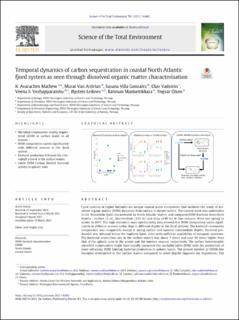| dc.contributor.author | Mathew, K Avarachen | |
| dc.contributor.author | Ardelan, Murat Van | |
| dc.contributor.author | Villa Gonzalez, Susana | |
| dc.contributor.author | Vadstein, Olav | |
| dc.contributor.author | Sajith Vezhapparambu, Veena | |
| dc.contributor.author | Leiknes, Øystein | |
| dc.contributor.author | Mankettikkara, Rahman | |
| dc.contributor.author | Olsen, Yngvar | |
| dc.date.accessioned | 2021-04-28T08:01:01Z | |
| dc.date.available | 2021-04-28T08:01:01Z | |
| dc.date.created | 2021-04-15T15:26:27Z | |
| dc.date.issued | 2021 | |
| dc.identifier.citation | Science of the Total Environment. 2021, 782 . | en_US |
| dc.identifier.issn | 0048-9697 | |
| dc.identifier.uri | https://hdl.handle.net/11250/2740059 | |
| dc.description.abstract | Fjord systems in higher latitudes are unique coastal water ecosystems that facilitate the study of dissolved organic matter (DOM) dynamics from surface to deeper waters. The current work was undertaken in the Trondheim fjord characterized by North Atlantic waters, and compared DOM fractions from three depths - surface (3 m), intermediate (225 m) and deep (440 m) in four seasons, from late spring to winter in 2017. The high-resolution mass spectrometry data showed that DOM composition varies significantly in different seasons rather than in different depths in the fjord systems. The bacterial community composition was comparable except at spring surface and summer intermediate depths. Bacterial production was minimal below the euphotic layer, even with sufficient availability of inorganic nutrients. The bacterial production rate in the surface waters was about 7 times and over 50 times higher than that of the aphotic zone in the winter and the summer seasons, respectively. The surface heterotrophic microbial communities might have rapidly consumed the available labile DOM, with the production of more refractory DOM limiting bacterial production in aphotic layers. The greater number of CRAM-like formulas determined in the surface waters compared to other depths supports our hypothesis. The refractory DOM sequestered in the water column may either be exported into sediments attached to particulate matter and marine gels, or may escape into the atmosphere as carbon dioxide/monoxide during the photochemical oxidation pathways, suggesting that it is involved in climate change scenarios. | en_US |
| dc.language.iso | eng | en_US |
| dc.publisher | Elsevier | en_US |
| dc.rights | Attribution-NonCommercial-NoDerivatives 4.0 Internasjonal | * |
| dc.rights.uri | http://creativecommons.org/licenses/by-nc-nd/4.0/deed.no | * |
| dc.subject | Marine Science | en_US |
| dc.subject | Marine Scieence | en_US |
| dc.title | Temporal dynamics of carbon sequestration in coastal North Atlantic fjord system as seen through dissolved organic matter characterisation | en_US |
| dc.type | Peer reviewed | en_US |
| dc.type | Journal article | en_US |
| dc.description.version | publishedVersion | en_US |
| dc.subject.nsi | VDP::Matematikk og naturvitenskap: 400 | en_US |
| dc.subject.nsi | VDP::Mathematics and natural scienses: 400 | en_US |
| dc.source.pagenumber | 15 | en_US |
| dc.source.volume | 782 | en_US |
| dc.source.journal | Science of the Total Environment | en_US |
| dc.identifier.doi | 10.1016/j.scitotenv.2021.146402 | |
| dc.identifier.cristin | 1904358 | |
| dc.relation.project | Norges teknisk-naturvitenskapelige universitet: Internal Funding | en_US |
| dc.relation.project | EC/FP7/603773 | en_US |
| cristin.ispublished | true | |
| cristin.fulltext | original | |
| cristin.qualitycode | 2 | |

